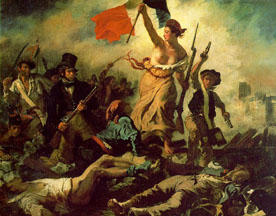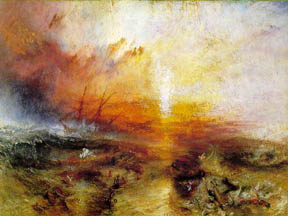.
Highlights From the 19th Century

Jacques Louis David
The Death of Marat, 1793
|

Jean Auguste Dominique
Ingres
La Odalisque, 1814
|
There were three basic styles
that held sway througout the 19th century. The first of these was NeoClassicism (led by Jacques Louis David), which was a reaction to the frivolous style
of the French Rococo. He and his followers represented the ideals of the
French Revolution. They desired an art form which was dignified and reflected
their serious concerns. Opposing the flowery and decorative compositions
of the Rococo, their work stresses rationality and clearly delineated forms. The Death of Marat is a good example,and portrays a martyred leader
of the Revolution, killed in his bathtub. Ingres was one of David's followers,
and has the clearly dilineated forms of classical style of David, but a
less serious story to tell. The woman is a harem girl, or concubine.

Eugene Delacroix
Liberty Leading the People, 1830
|

Francisco Goya (Spanish)
The Third of May, 1808 (1814)
|
Another style of the 19th century
is known as Romanticism. Those who followed this trend felt that
portrayal of emotion was more important than rationality. They generally
preferred a more dramatic and painterly approach. Politically, they are
aligned with the counter-revolution, led against Napoleon's despotic rule.
Delacroix symbolizes the battle with an allegorical figure of Victory leading
the revolutionaries through the battlefield. Goya's painting portrays a
historical event of Napoleon's soldiers killing citizens in the occupies
territories of Spain. The dramatic gesture of the spotlighted man is one
begging for mercy, but the spilled blood of others tells you what will be
his fate.

Gustave Courbet (French)
Wounded Man, 1844
|

William Adolfe Bougeuereau
(French)
Rest at Harvest, 1865
|
A third style reflecting the 19th century is that of Realism. The realists
were opposed to the often mythological character of many Neoclassical and
Romantic artworks. Their basic philosophy is that one should paint what one
sees with their own eyes, and leave any mythological or overly dramatic content
out of the picture. It is difficult to understand this concept if you think
of realism only in terms of the artist's ability to portray a believable image.
The "reality" is more a matter of concept. A wounded man, for example,
is something one might actually see. A bare-breasted woman charging across
a battlefield is not. The issue is further complicated by the fact that some
artists present more than one style. The Rest at Harvest, above, looks
like a fairly straight-forward, realistic image. Other works by the same artists,
however, portray mythological subjects. There are no clear cut lines between
the three styles, and many artists of the century are difficult to categorize
into one specific style.
.

Theodore Gericault (French)
The Raft of the Medusa, 1819
|

Thomas Eakins (American)
Max Schmidt in a Single Scull
|
The above two images contrast a
Romantic work with a realist one. The Raft of the Medusa portrays a
shipwreck in which the crew took the lifeboats to safety, leaving the passengers
to create their own raft. It was a tragic event in which many of the passengers
died. Gericault's painting depicts the last survivors in writhing poses as
they spot a ship in the distant horizon. Though it portrays an actual event,
the artist was not there to witness it, and his composition dramatizes its
tragedy by including some of the dead, who would have actually been thrown
off the raft. Eakins, by contrast, paints a scene which he witnesses with
his own eyes. His mastery as a painter lies in his ability to capture only
that which can be perceived with his own senses, and the story is a simple
sporting event. Eakins was also a pioneer of the photographic medium, and
often used photographs to aid his paintings.
.

John Singer Sargent (Amer.)
Madame X
|

J.W. Turner (British)
The Slave Ship, 1840
|

James Whistler (Amer.)
Symphony in White, 1862
|
Two important American portrait painters were Sargent and Whistler. They
would both be termed realists, though Whistler did do some landscape compositions
which were almost impressionistic (and he preferred musical titles, rather
than descriptive ones). J.W. Turner's explosive landscapes and seascapes
can probably be described as romantic, for they always focus on stormy compositions.
He painted with a loose brushstroke, which will also be an inspiration to
the Impressionists.

Winslow Homer
The New Novel (detail), 1877
|

Sir John Everett Millais
Ophelia, 1851-2
|
Winslow Homer, an American, is probably best categorized as a realist, for
he painted only what he actually observed. He is probably best known for
his seascapes, but also painted children and other subjects. He is a master
of the watercolor medium.
Sir John Everett Millais, a British
artist, has a realistic style, but the subjects are often of a somewhat
romantic nature. For example, Ophelia has a literary reference to a play
by Shakespeare, since she was Hamlet's girlfriend who commits suicide. This
painting of her dead body floating down a brook is both beautiful and haunting.

Dante Gabriel Rosetti
(Brittish)
La Ghirlandata, 1873
|

Edward Burne-Jones (Brittish)
The Garden of Hesperides, 1870-77
|
Dante Gabriel Rosetti was the leader
of an art movement called the PreRaphaelites. I believe this style might be
considered a varient of Romanticism, for it favors subjects of mythological
and literary subjects. They preferred symbolic representations with a certain
poetic appeal. Edward Burne-Jones was another prominent member of the Pre-Rapaelite
movement who favored allegorical and poetic subjects.
.

Albert Bierstadt (German-born
American)
Looking Down the Yosemite Valley, 1865
|

Frederick Church (American)
Catopaxi, 1862
|
Landscape painting is also very
popular during the 19th century, and there are small schools or "clicks"
of painters who work in specific regions. The Hudson River Painters are
a group who concentrated on painting scenes west of the Hudson River. These
are generally done on huge canvases. Though realistic in one sense, they
also have a grandiose effect, and they preferred dramatic lighting conditions.
.

John James Audubon
(American)
White Gerfalcons
|

Martin Heade (American)
Cattelyn Orchid and Brazilian Hummingbirds, 1871
|
Along with a growing interest
in landscape, artists portrayed intimate scenes from nature. Audubon is
probably the most famous illustrator of animals in America, especially known
for his hundreds of representations of birds. Martin Heade is also well-known
for his exotic images of birds and plants which he observed in South America.
.
|

Henri Rousseau
Sleeping Gypsy, 1887
|
Rousseau is in yet another category
altogether. The romantic element of these works is that they focus much
more on the inner life of the imagination than they do on anything which
can be seen by one's outward eyes. The psychological and fantastic nature
of this Rousseau's "naively inspired" works will be of influence
to a 20th century movement called Surrealism.
.
Another 19th century artist who
will be influential in the 20th century is Eduard Manet. His lack of reliance
on mythological or literary subjects places him as a realist. His Luncheon
on the Grass (Le Dejeuner sur l'Herbe) was scandalous during
its time, not because the woman is nude, but because she has no specific
reason to be so. A nude woman (even in the presence of clothed men) is not
unprecedented. What is unusual, however, is that she is not portraying a
mythological subject. Staring directly at the viewer without any veil of
poetic allegory, she is not nude, but "naked". She was also a
recognized woman within Parisan society, adding to its controversy. In
addition, Manet's manner of painting was more sketchy and flat than those
of his contemporaries. This manner of more spontaneous painting as well
as his focus on subjects of everyday life (such as the girl at the bar,
above) will greatly influence the Impressionists.
Next: Impressionism
.
|